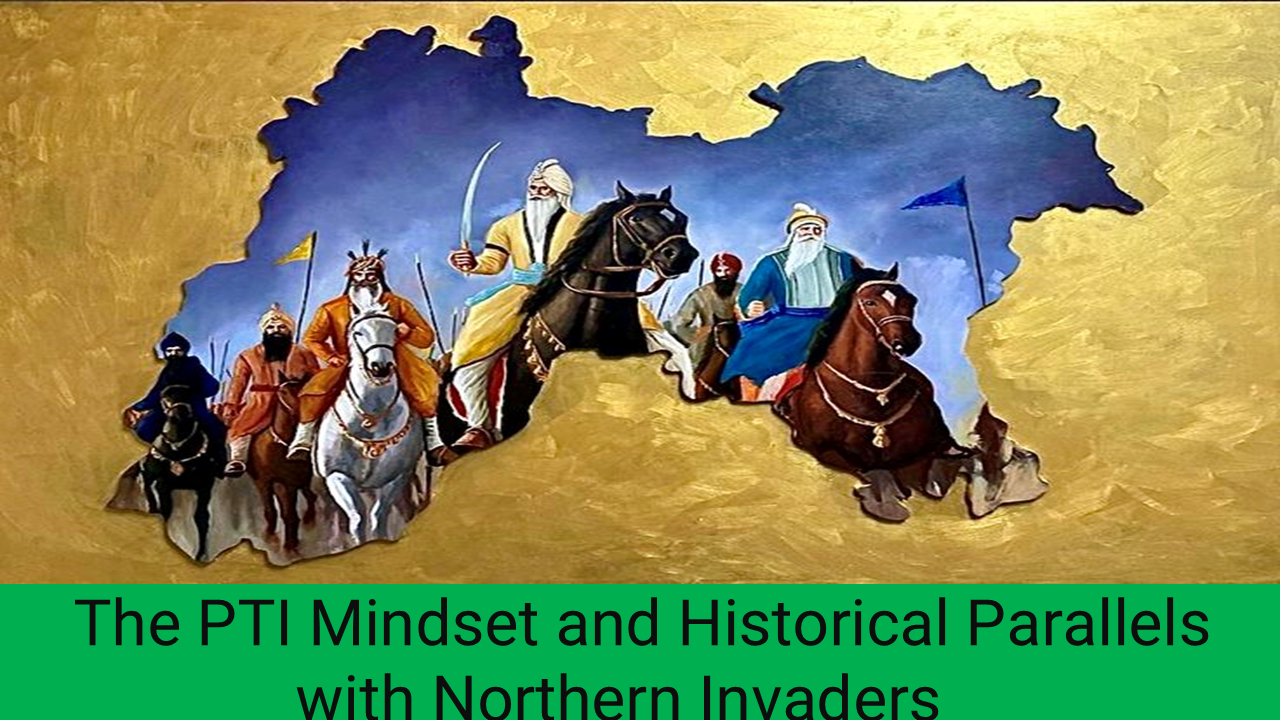Introduction
The rise of Pakistan Tehreek-e-Insaf (PTI) under the leadership of Imran Khan has been a significant phenomenon in Pakistan’s political landscape. However, its approach, political strategies, and rhetoric have often sparked controversy, leading critics to draw parallels between the mindset of PTI and the historical invaders from the north, such as Mahmud of Ghazni, Ahmad Shah Abdali, and Nader Shah Durrani. These invaders, accompanied by looters and allied tribes, ravaged Punjab over centuries, leaving a legacy of devastation and plunder. While the analogy may appear exaggerated at first glance, a deeper historical and sociopolitical analysis reveals some intriguing similarities in approach, rhetoric, and underlying motivations. This article explores these parallels, focusing on the PTI’s use of the “Pashtun card” and the apparent detachment of Punjabis from PTI-led strikes and long marches.
Historical Context: Northern Invaders and Punjab’s Plight
From the medieval period to the 18th century, Punjab served as a corridor and battleground for various invaders from the north. Mahmud of Ghazni launched numerous raids into the Indian subcontinent in the 11th century, looting wealth and establishing temporary dominance. Similarly, Ahmad Shah Abdali, often remembered for his invasions of Punjab during the mid-18th century, left a trail of destruction. Nader Shah’s invasion in 1739 marked another dark chapter, with the plunder of Delhi and Punjab’s subjugation.
The common thread among these invaders was their opportunistic approach—capitalizing on Punjab’s geographic centrality and relative wealth while forming temporary alliances with local and foreign tribes to facilitate their conquests. These incursions not only disrupted the region’s sociopolitical fabric but also sowed deep-rooted mistrust among the indigenous populations toward external forces.
PTI’s Political Strategy and Its Northern Parallels
-
The Opportunistic Approach
PTI’s political journey exhibits a pattern of exploiting opportunities and capitalizing on existing vulnerabilities, much like the northern invaders. For instance, the party’s rhetoric often emphasizes reform and anti-corruption, appealing to a populace disillusioned with traditional political elites. However, its actions frequently contradict these claims, with shifting alliances and a focus on consolidating power. The party’s reliance on mass protests, dharnas (sit-ins), and disruptive tactics mirrors the chaos and destabilization tactics used by historical invaders to weaken opposition and assert dominance.
-
Alliances with Diverse Groups
Just as northern invaders forged temporary alliances with Afghan tribes and local collaborators, PTI has strategically allied with various political and social groups to achieve its objectives. From its initial alignment with progressive urban youth to later accommodations with conservative religious factions, the party’s alliances reflect a pragmatic, albeit inconsistent, strategy. This opportunism often blurs the ideological lines, much like the mixed motives of historical invaders who sought power over coherence.
-
Plunder of Political Norms
While historical invaders looted material wealth, PTI’s critics argue that it has undermined Pakistan’s political norms and institutions. Its confrontational approach, disregard for parliamentary processes, and frequent challenges to judicial authority have contributed to a sense of instability. This behavior echoes the invasive disruptions that northern conquerors inflicted on Punjab’s political and administrative systems.
The “Pashtun Card” and Its Historical Echoes
-
Identity Politics and Division
PTI’s use of the “Pashtun card” draws from a historical playbook where ethnic and tribal identities were mobilized for strategic gains. Historically, Pashtun tribes played pivotal roles in supporting northern invaders, either through active participation or by providing logistical support. Similarly, PTI has at times framed itself as a representative of Pashtun interests, leveraging Imran Khan’s Pashtun heritage to appeal to this demographic.
-
Mobilization Through Rhetoric
PTI’s rhetoric often invokes a narrative of marginalization and empowerment, resonating with Pashtun communities that feel underrepresented in mainstream politics. This approach parallels the mobilization strategies of northern invaders who rallied tribal loyalties by exploiting local grievances and promising shared spoils.
-
Consequences of Ethnic Framing
The use of the “Pashtun card” has also fueled tensions in regions like Punjab, where ethnic dynamics are complex and historically fraught. Punjab, historically a target of northern invasions, harbors memories of external domination and exploitation. PTI’s perceived alignment with Pashtun identity risks alienating Punjabi populations, who may view this as a continuation of historical patterns of external interference.
Punjabi Detachment: Historical and Contemporary Dimensions
-
Historical Mistrust of Outsiders
Punjab’s historical experience with northern invaders has fostered a sense of skepticism toward external forces and their motives. This mistrust persists in the collective memory and informs Punjabi attitudes toward political movements perceived as disruptive or externally influenced.
-
Economic and Social Priorities
Punjabis have traditionally prioritized stability and economic well-being over revolutionary politics. This pragmatic approach stems from centuries of survival under turbulent conditions. PTI’s disruptive tactics, such as strikes and long marches, are therefore met with apathy in Punjab, where people often associate such actions with historical cycles of chaos and exploitation.
-
Resistance to PTI’s Narrative
The general detachment of Punjabis from PTI’s protests and long marches reflects a broader resistance to the party’s narrative. Many Punjabis view PTI’s tactics as a threat to the region’s hard-won stability, echoing historical resistance to invaders who disrupted local economies and social structures.
Changing Circumstances and Evolving Mentalities
-
Modern State Structures
Unlike the fragmented political landscape of historical Punjab, contemporary Pakistan operates within a framework of modern state structures. This institutional framework imposes checks and balances that limit the extent of any single entity’s dominance, including PTI. While the party may exhibit traits reminiscent of historical invaders, its actions are constrained by democratic norms and public accountability.
-
Information Age Dynamics
The proliferation of media and information technology has transformed political mobilization. PTI’s use of social media to propagate its message and rally supporters contrasts with the physical and militaristic strategies of historical invaders. However, the underlying principle of exploiting public sentiment for strategic gain remains a common thread.
-
Evolving Public Awareness
The Pakistani populace, particularly in Punjab, has grown more politically aware and discerning. While PTI’s rhetoric may resonate with certain segments, its strategies are increasingly scrutinized. This evolving awareness represents a departure from the passive victimhood of historical Punjab under northern invaders.
Conclusion
The parallels between PTI’s mindset and the historical invaders from the north offer a fascinating lens to examine the party’s political strategies and public reception. While the analogy highlights shared traits such as opportunism, disruption, and alliance-building, it also underscores significant differences rooted in contemporary realities. The use of the “Pashtun card” and the detachment of Punjabis from PTI’s protests reflect deeper historical and sociopolitical dynamics that continue to shape Pakistan’s political landscape.
Understanding these dynamics requires a nuanced appreciation of history, identity, and regional sensitivities. By learning from the past and addressing present challenges with greater inclusivity and responsibility, Pakistan can move toward a more stable and equitable future. For PTI, this means evolving beyond the tactics of disruption and division to embrace a politics of consensus and constructive engagement. Only then can it truly break free from the shadow of historical parallels and chart a path toward lasting progress.
To watch this article on Youtube, kindly click here:



